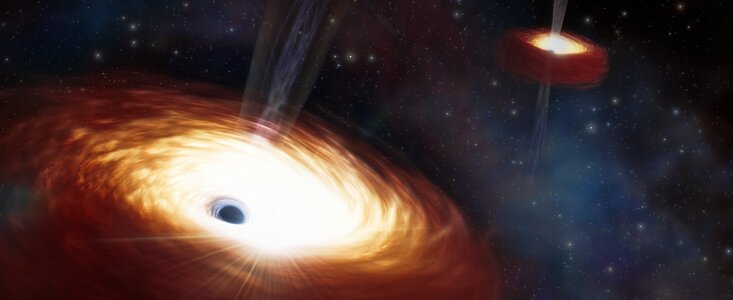Supermassive black holes have been found at the heart of most galaxies but understanding how they have formed has eluded astronomers for some time. One of the most popular theories suggests they merge over and over again to form larger black holes. A recent discovery may support this however the pair of supermassive black holes are orbiting 24 light years apart and measure an incredible 28 billion solar masses making it the heaviest ever seen.
A black hole is a region of space within which the escape velocity is greater than the speed of light. Ok so the definition is a little more complicated than that but that will suffice for now. They are objects that have undergone gravitational collapse with their largest versions, the supermassive black holes which have a mass from hundreds of thousands to billions of times that of the Sun. It’s now thought that nearly every massive galaxy has a supermassive black hole at its core.
Galaxy mergers seem to be common with many examples visible in the sky like the classic Whirlpool Galaxy in the northern hemisphere. When they do, it is thought their black holes can form a binary pair. Ultimately it is believed they merge however this has never been observed. A paper that was recently published in the Astrophysical Journal and authored by a team led by Tirth Surti explores this process.

One such binary black hole system exists inside elliptical galaxy B2 0402+379 (a catchy name if ever there was one) and the team analysed its data from the Gemini North Telescope. It’s possible to resolve this binary system so the team could study it in more detail than any before. The black holes are separated by only 24 light years and data shows the system to be an impressive 28 billion times the mass of the Sun.
The team studied the stars in the vicinity of the black holes using the Gemini Multi-Object Spectrograph (GMOS) so they could determine their velocity. Measuring the velocity enabled the team to determine the mass of the black hole binary pair but also supports the theory that the mass of the black hole plays a role in delaying and even stalling their merging!
It turns out that B2 0402+379 is a so called ‘fossil cluster’ which means that it is the result of the merging of an entire cluster of galaxies. After such mergers, the black holes don’t crash head on into each other, instead they tend to swing by each other and fall into a bound orbit around a common centre of gravity. As they swing by each other, energy is transferred from the black holes to the nearby stars. As they lose energy, they get closer and closer and in the case of stellar mass black holes, they merge. This never seems to happen with supermassive binary black holes.
In the case of binary black holes with large mass, the team propose that a huge number of stars would be needed in the vicinity to slow them sufficiently to bring them close enough to merge. Instead, the black holes seem to have ejected nearly all the matter from the region leaving it local mass low enough that the pair’s orbits are not able to slow and merge. Whether this is the ultimate fate and the binary pair are destined to orbit forever or eventually merge is still yet to be determined. If they do merge however, it is likely that the resultant gravitational wave will be far more powerful, potentially hundreds of millions of times more than a stellar mass merger.
Source : Astronomers Measure Heaviest Black Hole Pair Ever Found


The two methods used for mass estimates are the photometric method for the galaxy and kinematic for the SMBH core. The dynamical friction to merger the two SMBH candidates are discussed in terms of stars (gravitational friction via three-body gravitational slingshots).
But recently there has been suggestions that dark matter could facilitate gravitational friction as well, and that was not excluded.